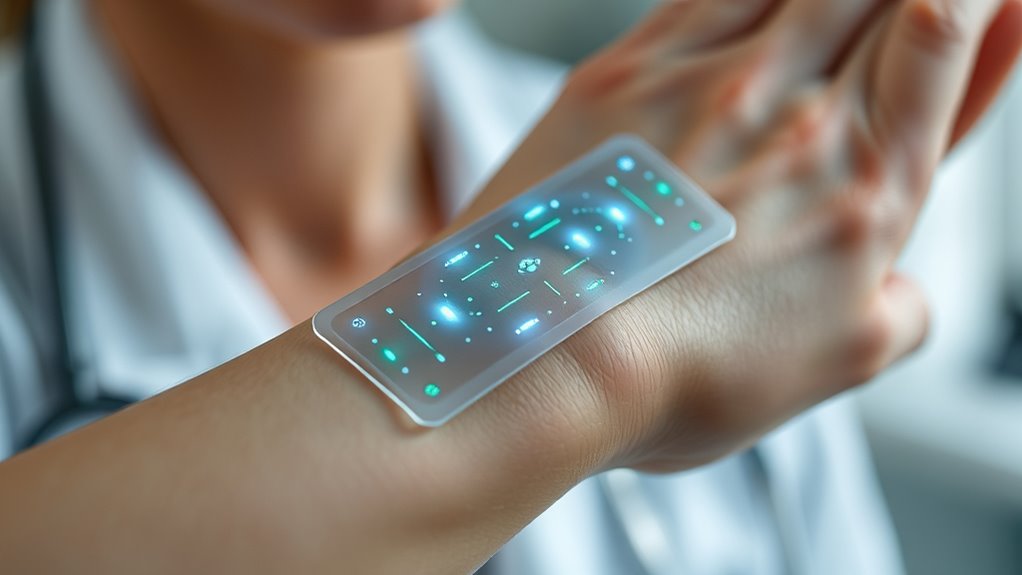Smart bandages with real-time wound monitoring use embedded sensors that track inflammation, infection, and moisture levels to give instant feedback on healing progress. These bandages often feature color-changing indicators or electrochemical sensors for precise biomarker detection. Wireless data transmission allows healthcare providers to monitor your wound remotely, enabling quick interventions if needed. By combining therapy options like electrical stimulation and drug delivery, these devices personalize treatment. Keep exploring to discover how this innovative technology can help manage wounds more effectively.
Key Takeaways
- Incorporate colorimetric or electrochemical sensors to detect inflammation and infection markers in real time.
- Utilize microfluidic systems to manage wound fluid and enable continuous biomarker analysis.
- Transmit wound data wirelessly for remote monitoring and timely clinical intervention.
- Employ machine learning algorithms to assess wound healing progress and predict complications.
- Integrate therapeutic functionalities like electrical stimulation or drug delivery for personalized treatment.

Smart bandages are transforming wound care by providing real-time monitoring of your wounds, enabling early detection of complications like infection or excessive inflammation. These advanced dressings incorporate various sensor technologies that continuously assess the wound environment. Colorimetric sensors change color visibly or can be read by image recognition algorithms to reveal changes in your wound’s physiological state. For example, they can detect inflammation markers such as nitric oxide or infection indicators like hydrogen peroxide days before you notice symptoms, giving you and your healthcare team valuable early warning signs. Electrochemical sensors, using enzyme-modified electrodes, measure biomarkers via electrical signals generated from redox reactions, offering precise data about your wound’s condition.
Microfluidic components play a vital role by managing wound fluid, ensuring fresh samples are available for accurate, real-time biomarker analysis. This setup allows the sensors to provide thorough, continuous monitoring of the wound environment, combining multiple sensing modalities to give a detailed picture of healing progress and potential issues. The data collected isn’t just for static review; it’s transmitted wirelessly, so you and your healthcare provider can track your wound remotely. This real-time data allows for immediate intervention if signs of infection or excessive inflammation appear, reducing delays in treatment and preventing complications. Machine-learning algorithms analyze the sensor data, classifying wounds, predicting healing timelines, and supporting clinical decisions with accuracy comparable to that of experienced professionals. Sensor integration remains a key challenge in advancing this technology and ensuring consistent performance across different wound types.
Many smart bandages don’t just monitor—they actively promote healing. Embedded electrodes can deliver electrical stimulation to encourage cell growth and new blood vessel formation, speeding up recovery. Responsive materials enable on-demand drug delivery directly to the wound, ensuring the right medication is applied precisely when needed. Localized antibacterial treatments, triggered by photothermal materials, help reduce infection risks, while hydrogel layers maintain ideal moisture levels for tissue repair and patient comfort. This integrated approach creates a closed-loop system, personalizing wound management and enhancing healing outcomes.
While particularly beneficial for chronic wounds like diabetic ulcers, pressure injuries, and vascular leg ulcers, smart bandages aren’t typically used for straightforward, acute wounds that heal normally with traditional dressings. They aren’t suitable for large or severely infected wounds requiring surgical care either. Clinical trials have shown their effectiveness in patients with complex wounds, especially those with impaired circulation or diabetes. By detecting problems early, they help decrease hospital stays and lower the risk of amputations, making wound care safer and more efficient.
Compared to traditional dressings, smart bandages offer faster, objective, and continuous assessment of your wound. They support remote monitoring, reducing the need for frequent clinic visits, and help maintain ideal healing conditions, which can minimize scarring. Ultimately, they cut healthcare costs by preventing severe complications and speeding up recovery, though challenges remain in integrating sensors, power sources, and therapeutic elements seamlessly.
Frequently Asked Questions
How Long Do Smart Bandages Typically Last Before Needing Replacement?
You’re wondering how long smart bandages last before needing replacement. Typically, their lifespan depends on the sensor type, power source, and electronics. Reusable models with durable components can last weeks with proper care, while disposable ones are usually replaced every few days. Battery life and sensor saturation also limit use, often requiring replacements during wound assessments or when the device malfunctions. Proper maintenance helps extend their usability, but replacement timing varies by design.
Are Smart Bandages Safe for All Skin Types?
Imagine a gentle embrace that adapts to your skin—smart bandages are designed with this in mind. They’re generally safe for all skin types, thanks to biocompatible materials like hydrogels that retain moisture and reduce irritation. While most people tolerate them well, individuals with allergies or sensitive skin should monitor for reactions and consult healthcare providers. Overall, these bandages balance innovation with safety, aiming to protect and heal your skin effectively.
Can Smart Bandages Be Used on Deep or Complex Wounds?
You ask if smart bandages can be used on deep or complex wounds. While they’re mainly designed for surface wounds, ongoing research aims to adapt them for deeper wounds. They offer benefits like real-time monitoring and electrical stimulation, which can help complex healing. However, limitations like sensor penetration and therapy distribution exist. Advances in electrode design and delivery methods are needed before they become widely effective for deep or intricate wounds.
What Is the Cost Comparison Between Smart and Traditional Bandages?
You want to compare costs between smart and traditional bandages. Smart bandages cost about $1 per application, while traditional ones vary from $0.50 to $5. Depending on the type, advanced dressings can be $10 to $50. Although smart bandages are slightly more expensive upfront, they often heal wounds faster, reduce complications, and lower overall treatment costs, making them a more cost-effective option long-term.
How Do Smart Bandages Communicate Wound Data to Healthcare Providers?
You want to know how smart bandages share wound data with healthcare providers. They use wireless technologies like Bluetooth Low Energy (BLE), NFC, or custom radiofrequency modules to transmit real-time sensor readings. These sensors track moisture, pH, temperature, and other biomarkers, sending data to external devices like smartphones or hospital systems. This continuous, wireless flow enables remote monitoring, early detection of issues, and timely intervention without frequent in-person visits.
Conclusion
Imagine these smart bandages as vigilant guardians, silently watching over your wounds like sentinel stars guiding you through healing’s night. Their real-time monitoring transforms recovery from a passive wait into an active dance of precision and care. With each heartbeat of data, they illuminate the path to quicker, smarter healing. Embrace this luminous leap forward—your wounds now have a guardian angel, ensuring you heal not just faster, but wiser, in a symphony of innovation and hope.










